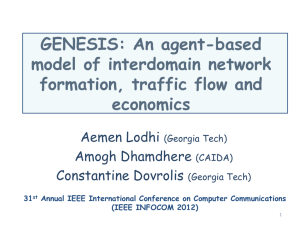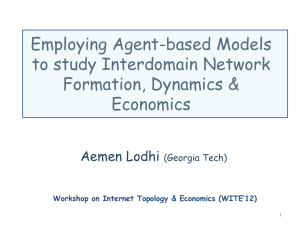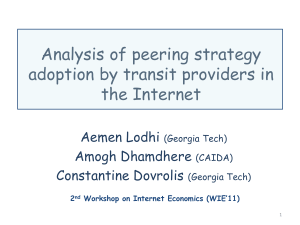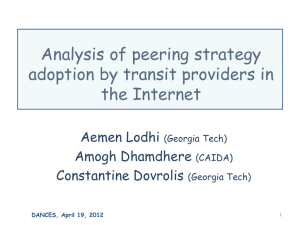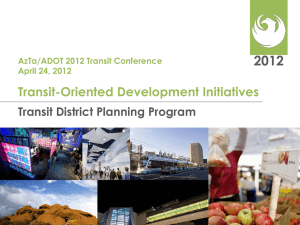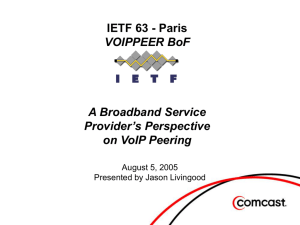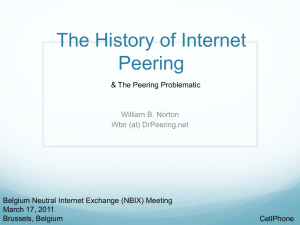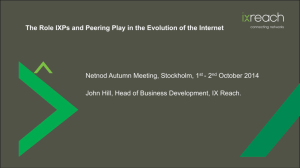slides
advertisement
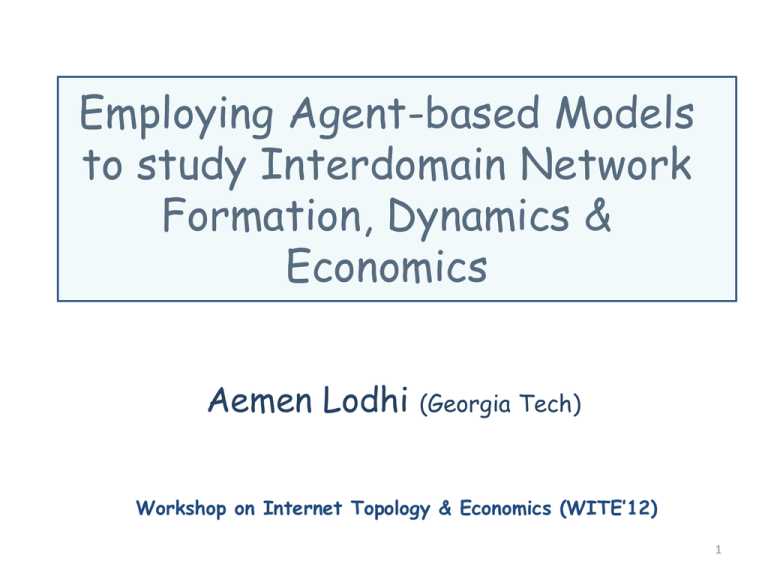
Employing Agent-based Models to study Interdomain Network Formation, Dynamics & Economics Aemen Lodhi (Georgia Tech) Workshop on Internet Topology & Economics (WITE’12) 1 Outline • Agent-based modeling for AS-level Internet • Our model: GENESIS • Application of GENESIS – Large-scale adoption of Open peering strategy • Conclusion 2 What is the environment that we are we trying to model? • Autonomous System level Internet • Economic network Internet Transit Provider Enterprise customer Transit Provider Content Provider Content Provider Enterprise customer 3 What is the environment that we are we trying to model? • Complex, dynamic environment – Mergers, acquisitions, new entrants, bankruptcies – Changing prices, traffic matrix, geographic expansion • • • • Co-evolutionary network Self-organization Information “fuzziness” Social aspects: 99% of all peering relationships are “handshake” agreements* *”Survey of Characteristics of Internet Carrier Interconnection Agreements 2011” – Packet Clearing House 4 What are we asking? • Aggregate behavior – Is the network stable? – Is their gravitation towards a particular behavior e.g., Open peering – Is their competition in the market? • Not so academic questions – Is this the right peering strategy for me? – What if I depeer AS X? – Should I establish presence at IXP Y? – CDN: Where should I place my caches? 5 Different approaches • Analytical / Game-theoretic approach • Empirical studies • Generative models e.g., Preferential attachment • Distributed optimization • Agent-based modeling 6 Why to use agent-based modeling? • Incorporation of real-world constraints – Non-uniform traffic matrix – Complex geographic co-location patterns – Multiple dynamic prices per AS – Different peering strategies at different locations • Scale – hundreds of agents • What-if scenarios • Understanding the “process” and not just the “end-state” 7 Why not to use agent-based modeling? • Large parameterization space – Systematic investigation of full parameter space is difficult • Validation • Computational cost • Under some circumstances reasoning may be difficult e.g. instability in a model with hundreds of agents 8 GENESIS 9 The model: GENESIS* • Agent based interdomain network formation model • Fundamental unit: An agent (AS) with economic interests • Incorporates – Co-location constraints in provider/peer selection – Traffic matrix – Public & Private peering – Set of peering strategies – Peering costs, Transit costs, Transit revenue *Aemen Lodhi, Amogh Dhamdhere, Constantine Dovrolis, “GENESIS: An agent-based model of interdomain network formation, traffic flow and economics,” InfoCom 2012 10 Peering link at top tier possible Geographic Link formation across regions across overlap geography not possible Geographic presence & constraints Regions corresponding to unique IXPs 11 The model: GENESIS* Fitness = Transit Revenue – Transit Cost – Peering cost • Objective: Maximize economic fitness • Optimize connectivity through peer and transit provider selection • Choose the peering strategy that maximizes fitness Peering strategies • Restrictive: Peer only to avoid network partitioning • Selective: Peer with ASes of similar size 𝑉𝑥 ≤𝜎 𝑉𝑦 𝑉𝑥 = 𝑇𝑟𝑎𝑛𝑠𝑖𝑡 + 𝐺𝑒𝑛𝑒𝑟𝑎𝑡𝑒𝑑 + 𝐶𝑜𝑛𝑠𝑢𝑚𝑒𝑑 • Open: Every co-located AS except customers • Choose peering strategy that is predicted to give maximum fitness 13 Peering strategy adoption Open Selective 1 2 Open 3 Time Depeering Peering Transit Provider selection • No coordination, limited foresight • Eventual fitness can be different • Stubs always use Open peering strategy 14 Application of GENESIS: Analysis of peering strategy adoption by transit providers in the Internet* *Aemen Lodhi, Amogh Dhamdhere, Constantine Dovrolis, “Analysis of peering strategy adoption by transit providers in the Internet,” NetEcon 2012 15 Motivation: Existing peering environment • Increasing fraction of interdomain traffic flows over peering links* • How are transit providers responding? Transit Provider Content Provider/CDN Access ISP/Eyeballs *C. Labovitz, S. Iekel Johnson, D. McPherson, J. Oberheide and F. Jahanian, “Internet Interdomain Traffic,” in ACM SIGCOMM, 2010 16 Motivation: Existing peering environment • Peering strategies of ASes in the Internet (source: PeeringDB www.peeringdb.com) • Transit Providers peering openly ? 17 Approach • Agent based computational modeling • Corroboration by PeeringDB data • Scenarios Without-open • Selective • Restrictive vs. *Stubs always use Open With-open • Selective • Restrictive • Open Percentage of transit providers Strategy adoption by transit providers 100 90 80 70 60 50 Restrictive 40 Selective 30 Open 20 10 0 Without-open Conservative With -open Non-conservative Scenarios 19 Collective impact of Open peering on fitness of transit providers • Cumulative fitness reduced in all simulations 20 Impact on fitness of individual transit providers switching from Selective to Open • 70% providers have their fitness reduced 21 Why do transit providers adopt Open peering? Affects: • Transit Cost • Save Transit Revenue transit • Peering costs Cost v x y But your customers are doing the same! z w Why gravitate towards Open peering? x regains lost x adopts Open Options for transit revenue peering x? partially x lost transit revenue z w, traffic passes through x again! x y Not isolated Y peering openly decisions Network effects !! z w, z z y, traffic bypasses x w Conclusion • Employ agent-based models for largescale study of interdomain network formation • Parameterization and validation are difficult • Agent-based models can reveal surprising behavior 24 Conclusion • Gravitation towards Open peering is a network effect for transit providers (70% adopt Open peering) – Economically motivated strategy selection – Myopic decisions – Lack of coordination • Extensive Open peering by transit providers in the network results in collective loss 25 Thank you 26
